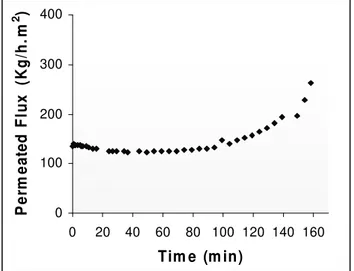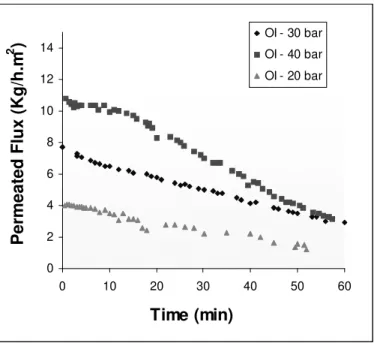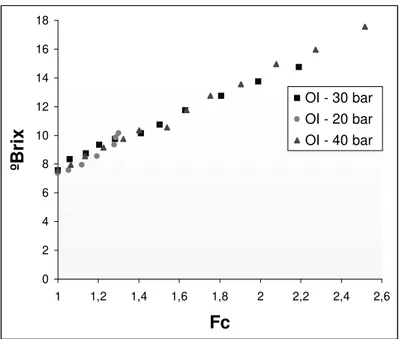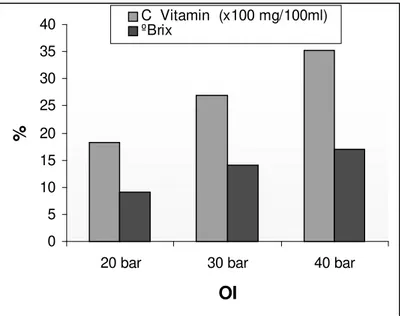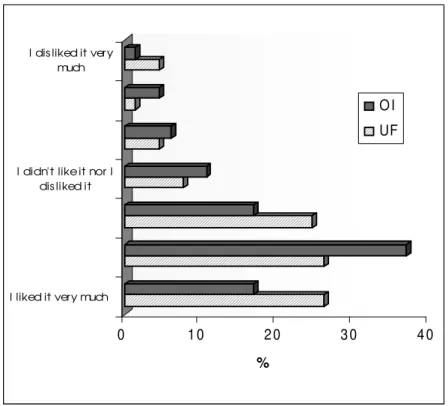Vol.48, Special n.: pp. 175-183, June 2005
ISSN 1516-8913 Printed in Brazil
BRAZILIAN ARCHIVES OF
BIOLOGY AND TECHNOLOGY
A N I N T E R N A T I O N A L J O U R N A L
Evaluation of the Acerola Juice Concentrated by Reverse
Osmosis
Eliane Rodrigues dos Santos Gomes
1*, Elisabete Scolin Mendes
2, Nehemias Curvelo
Pereira
2and Sueli Teresa Davantel de Barros
21
Teaching Department -Technological Education Federal Center (CEFET-PR); Unidade Oeste; Av. Brasil 4232; 85884-000; Medianeira - PR - Brasil. 2Chemical Engineering Department - State University of Maringá (UEM); Av. Colombo 5790; 87020-900; Maringá -PR -Brasil
ABSTRACT
The aim of this study was to obtain the acerola juice using separation processes with membranes. The acerola pulp was initially defrosted and treated with 100 ppm of Citrozym Ultra L enzyme at 45oC for one hour, then ultrafiltrated at 3 bar at 45oC using 0.1 µm ceramic membrane, and concentrated by reverse osmosis using a spiral membrane of a compound film. The pressures on the reverse osmosis were 20, 30, and 40 bar at environmental temperature, thus, resulting a juice with 9.76, 14.56, and 17.36 oBrix, respectively. The physicochemical characteristics of the juice were preserved and, studies on evaluation of the public acceptability, showed that 75% of the consumers liked the juice.
Key words: Acerola, Ultrafiltration, Reverse osmosis, C Vitamin, Concentration
*
Author for correspondence
INTRODUCTION
When referring to fruits, a modern concept concerning quality involves besides the characteristics of the fruits, the processes used during their production and commercialization. Cantillano (2001) emphasized that the quality of both the fruits and products derived from them could be defined by several factors, such as size, weight, color, texture, soluble solids, acidity, nutritive factors (minerals, vitamins, water, etc.), toxicological factors, and sanitary quality. In this context, the companies working with fruit processing have been trying to innovate, introducing in the market products made with natural fruit juice, and drinks, such as concentrated juices, isotonic drinks, and others, therefore, aiming at maximizing the value addition. Barros
(2002) point out that the separation processes, such as the juice clarification and concentration, have a fundamental role concerning quality. Since most fruit juices contain 75% to 95% of water, its removal reduces the costs with packages, storage and transportation, besides reducing the water activity, thus, prolonging the life of the fruit juice on the supermarkets’ shelves and, consequently, resulting in the improvement of the product quality.
There is great interest in acerola due to its potentiality in relation to vitamin C. The use of acerola by food and pharmaceutical industries has been progressively increasing and its industrial manufacturing results in several products, such as natural juice, concentrated juice, lyophilized juice, purée, sweets, stuffing, pills and capsules for pharmaceutical use, besides the production of pure ascorbic acid. It is also used to enrich juices and nectars of other fruits.
Cabral et al. (1998) and Matta (1999) carried out some studies on the cold sterilization of acerola juice by microfiltration in order to obtain a concentrated clarified juice, using membranes microfiltration followed by reverse osmosis. Researchers from the State University of Maringá city (UEM) -State of Paraná - have been trying since 1999 to equate the several parameters used during the ultrafiltration and concentration of acerola juice, as well as in other fruit juices. Fernandes (1999), used pectinases in acerola juice, that caused pectin hydrolysis leading to the flocculation of the protein-pectin complex, resulting in a low viscosity, thus, pointing out the advantages of the processes that use membranes, as well as showing other benefits, such as the increase of the amount of concentrated juice and clarity, stability and reduction of turbidity. Barros (2002), Balischi (2002), and Prato (2003) reported that the fruit juice clarification allowed the total removal of polysaccharides, part of the enzymes and other colloidal materials that caused both the turbidity and the formation of gel when concentrated. Balischi (2002) found an optimum treatment condition for the acerola pulp using the Citrozym Ultra L enzyme: 100 ppm at 45oC during 60 minutes.
Prato (2003), using the same conditions described by Balischi (2002), found that the enzymatic activity during the ultrafiltration caused the reduction of the pectin molecules, which tended to obstruct the 0.10 µm membrane pores, but even then resulted in a better permeated quality index (PQI) for the ultrafiltrated acerola. This index refers to the decrease of pectin, turbidity and pulp content, as well as to the increase of vitamin C and sugar in the juice produced.
Damasceno (2001) concentrated acerola juice by Reverse Osmosis, using a spiral membrane of a compound film, after ultrafiltration in a hollow fiber polysulphone membrane, reaching good results under pressures of 20, 30, and 40 bar. The soluble solid content changed from 6.2 to 16.2
o
Brix at 40 bar, and vitamin C increased approximately twice.
The aim of this study was to obtain concentrated acerola juice, combining three processes, enzymatic treatment, ultrafiltration and reverse osmosis.
MATERIALS AND METHODS
Enzymatic Treatment (ET)
For each of the enzymatic treatment 3.5 l of frozen pulps were defrosted and submitted to a pre-treatment with Citrozyn Ultra L enzyme (Novo Nordisk) at 100 ppm, with shaking of the liquid and incubation at 45oC. After this the pulp was drained in a thin domestic sieve and used for ultrafiltration (Balischi, 2002).
Ultrafiltration (UF)
The UF step was carried out according to a NETZSCH ultrafiltration pilot unit, 027.06-1C1/07-0005/AI, which used the tangential filtration principles with membrane (maximum tangential speed of 4.17 m/s) model. There was 5 liter feeding reservoir equipped with a Shumacher GmbH-Ti ceramic membrane ( -Al2O3/TiO2),
designed in tubular module with pores of 0.10 µm diameter, 25 cm of length, and an internal diameter of 0.7 cm. The working pressure was of 3 bar and the temperature of 45oC (3.5 l). The ultrafiltration was done according Prato (2003).
Concentration by Reverse Osmosis (RO)
Process efficiency
The ultrafiltration and the reverse osmosis process efficiency were evaluated from both the permeated flux (J), determined by the Equation 1, and the Fc concentration factor, determined by the
Equation 2.
t
A
V
J
P⋅
=
(1)(
V
V
)
V
F
p i
i
C
=
−
(2)Being A the permeation area, Vi the initial volume,
and Vp the permeated volume in a determined time
(t).
Quality Evaluation
The defrosted natural juice (ACE), enzymatically treated juice (ET), ultrafiltration permeated juice (UF) and juice concentrated by reverse osmosis (RO) were submitted to the following analyses.
Physicochemical analyses
pH, soluble solid content (oBrix), pulp content, acidity tritatable in citric acid (Adolfo Lutz, 1985); vitamin C (ascorbic acid), pectin, sugar reductors, and turbidity were performed using the methods mentioned by Barros (2002), Prato (2003) and Damasceno (2001).
Sensorial analysis
The acceptability test was done together with 65 consumers chosen at random from a bigger population. Samples of 30 ml of the juice were offered them at 10oC, at a pre-determined time and place. The questionnaire with Hedonic Scale of 7 points, varying from ‘I liked it very much’ (1) to ‘I disliked it very much’ (7) was applied (Teixeira et al., 1987). The samples were: permeated juice obtained by UF, diluted in 1:1 (v/v); concentrated juice obtained by RO, diluted in 1:2 and 1:3 (v/v). The portions were diluted into mineral water and sweetened with an average content of 10% sugar.
Considering the appreciation of the juice, other issues were included (habits and consume preferences) which could aggregate parameters related to the consumer’s point of view, in a more global evaluation concerning the product acceptability.
RESULTS AND DISCUSSIONS
Enzymatic Treatment
The mechanism that occurs during the enzymatic treatment has been described by Barros (2002) and Prato (2003), that is, considering the pectins as formers of a protecting layer on the proteins in suspension, in an acid environment (pH = 3.5): the pectinase degrades these pectins and exhibits part of the positively loaded protein. The formation of pectin-proteins flocs is facilitated by the rupture of pectin molecules due to the pectinolitic enzymes action. Therefore, due to the electrostatic repulsion, they group themselves between the particles. The results in relation to the use of this pulp in the ultrafiltration process were considered as good ones. An average reduction of 79% in the pectin content and of 50% in the pulp content was detected. Such values were similar to those estimated by Balischi (2002) who observed an average reduction of 67.7% in viscosity, 68.2% in pectin, and 19% in pulp content during the treatment. On the other hand, the Vitamin C had a reduction of 15% (Table 1).
Ultrafiltration
Considering nourishing values, a lack of turbidity, besides a reduction of 0.3% of Vitamin C, were observed in ultrafiltration permeate. Other parameters did not change (Table 1) and were similar to that reported by Prato’s (2003).
The permeated flux variation (J) and the concentration factor (Fc) obtained can be observed
in Figs. 1 and 2. At first, there was a very low permeated flux in relation to the membrane permeability (distilled water), i. e. of 4,000 kg/h.m2, on average. However, a slight increase in the permeated flux occurred along the time due to the continuous enzymatic action during ultrafiltration.
activation varied according to temperature and time, thus, increasing according to change of such factors (Balischi, 2002). The molecules continued to be broken into smaller molecules.The best
initial flux in 3.5 l of sequential ultrafiltration was 155.92 Kg/h.m2; the highest Fc was of 2.27 within
two hours and 38 minutes.
Table 1 - Average Physicochemical characteristics for the ACE, ET, and UF acerola
Analyses ACE ET UF
o
Brix 7.76 7.76 7.36
pH 3.39 3.31 3.35
C Vitamin (mg/100 ml) 1475.1 1252.4 1248.8
Turbidity (FAU) 283 41 a*
Density (g/ml) 1.03 1.03 1.02
% Total solids 7.7 7.8 7.1
Acidity (% citric acid) 1.0 1.2 1.2
Pectin (mg/100ml) 5.6 1.15 1.16
% Sugar reductors 4.71 4.91 4.92
*a - lack of
0 100 200 300 400
0 20 40 60 80 100 120 140 160
Tim e (m in)
P
e
rm
e
a
te
d Fl
u
x
(K
g
/h
.m
2 )
Figure 1 - Permeated flux variation in the UF at 3bar, 45ºC.
1 1.5 2 2.5
0 20 40 60 80 100 120 140 160 180
Time (min) Fc
0 2 4 6 8 10 12 14
0 10 20 30 40 50 60
Time (min)
Permeated Flux (Kg/h.m
2 )
OI - 30 bar
OI - 40 bar
OI - 20 bar
Figure 3 - Permeated flux variation in RO at different transmembrane pressures.
The Fc concentration factor increased according to
time, thus indicating that the retentate was more concentrated.
Concentration by Reverse Osmosis
The average fluxes of permeating in RO with the spiral membrane (in 50 min.) at average temperature of 23 ± 1oC, under 20, 30, and 40 bar can be observed in the Figs. 3 and 4 and in Table 2.
The best operational condition for the process was at 40 bar, in 45 min., and the oBrix reached 17.36o. These values was lower than the ones found by Matta (1999), but similar to values found by Damasceno (2001) who worked with the same type of membrane. For an identical Fc, oBrix
values under different pressures were obtained (Fig. 4).
The increasing of the transmembrane pressure causes a raising in the permeating flux and a minor time of concentration, if an equal Fc is considered.
Table 2 -Characteristics of RO process
Pressure (bar)
20 30 40
ºBrix (20ºC) 9.76 14.56 17.36
FC 1.30 2.19 2.52
Average Flux (kg/h.m2) 3.10 5.60 7.90
0 2 4 6 8 10 12 14 16 18
1 1,2 1,4 1,6 1,8 2 2,2 2,4 2,6
Fc
ºBrix
OI - 30 bar
OI - 20 bar OI - 40 bar
Figure 4 - The RO acerola oBrix variation as function concentration factor
Table 3 - Physicochemical characteristics of RO concentrated acerola
Análises 20bar 30bar 40bar
ºBrix 9.76 14.56 17.36
pH 3.39 3.32 3.31
C Vitamin (mg/100g) 1816.1 2686.9 3531.6
Turbidity (FAU) a* a* a*
Density (g/ml) 1.03 1.05 1.06
Total solids 9.5 14.6 17.6
Acidity (% citric acid) 1.3 2.3 2.6
Pectin (mg/100ml) 1.76 2.93 4.15
% Sugar reductors 6.15 9.87 11.29
*a - lack of
Physicochemical Evaluation
The results of the physicochemical analyses can be observed in Table 3. The pH of concentration acerola juice slightly diminishes due to the increase in organic acid contents. There was maintenance of sugar/acid ratio in acerola juice concentration. Other values were proportional to Fc and increased with the increase of transmembrane pressure.
C Vitamin
The increase in vitamin C concentration and oBrix is shown in Fig. 5. An increase of 45.4, 115.2, and 182.8% was obtained for Fcs of 1.3 (20 bar), 2.19
0 5 10 15 20 25 30 35 40
20 bar 30 bar 40 bar
OI
%
C Vitamin (x100 mg/100ml) ºBrix
Figure 5 - Comparison in % of both the oBrix and vitamin C in the RO concentrated acerola
Sensorial Evaluation
In general, 75% of the people who tasted the juice liked it, 53% of them identified the fruit (acerola), following parameters were studied about the juice: flavor, acidity, taste of the fruit, flavor, the taste of acerola, light and refreshing flavor, proximity with the fruit, different flavor, attractive color, etc. Some 66.2% mentioned its vitamin C potential. On average, 65% mentioned that they would buy the product.
Fig. 6 shows the result for the RO and UF juice acceptability test.
Diluted UF juice
Among the subjects who tasted the juice, 52.4% of them liked it very much or quite liked it (6.5 average), which indicated a good acceptability of the product. The juice did not present either the pulp or turbidity it was clear and limpid, showing a nice color (61.5%), varying from yellow to red, a good acidity (67.7%) with a peculiar aroma and a characteristic flavor.
Diluted RO juice
Among the subjects who tasted this juice, 53.8% liked it very much or quite liked it (6.3 average), indicating a good acceptability of the product. The juice did not has either the pulp or turbidity it was clear and limpid, also showing a nice color
(61.5%), varying from yellow to red, a good acidity (46.2%) with a peculiar aroma and characteristic flavor.
In a further study the evaluation of the microbiological and sensorial quality of the juice obtained and stored under refrigeration won’t be presented, as well as other concentration tests with the increase of temperature in a continuous course and at large-scale, aiming at achieving higher values of flux and permeation.
CONCLUSIONS
The results obtained during UF and RO separation processes concerning acerola juice showed theer potential as a good alternative to the concentration of fruit juice. RO permeated fluxes showed a typical decrease along the time, as well as with the Fc at different pressures. Juice physicochemical
characteristics and the lack of turbidity were also maintained. The vitamin C concentration was equivalent to the Fc juice concentration. This was
0 1 0 2 0 3 0 4 0
% I liked it very much
I didn't like it nor I dis liked it I dis liked it ver y
much
O I
UF
Figure 6 - The UF and RO acerola juice acceptability in %
ACKNOWLEDGEMENTS
We would like to thank the Chemical Engineering Department of the State University of Maringá -UEM, Teaching Department of the Technological Education Federal Center -CEFET-PR and to CAPES for their financial support.
RESUMO
O objetivo deste trabalho foi à obtenção de suco de acerola utilizando processos de separação com membranas. Combinou-se a ultrafiltração e a osmose inversa, visando a melhoria do processo produtivo, utilizando-se uma tecnologia limpa. Para a acerola, visou-se manter e concentrar significativamente seu teor de vitamina C, obtendo-se um suco com sabor agradável, o mais próximo possível do suco in natura. A polpa de acerola foi inicialmente descongelada e tratada com 100 ppm da enzima Citrozym Ultra L, à 45º C por 1 hora e posteriormente ultrafiltrada a 3 bar na mesma temperatura em membrana cerâmica de 0,1 µm e na seqüência, concentrada por osmose inversa utilizando membrana espiral de filme composto. As pressões na osmose inversa foram
20, 30 e 40 bar em temperatura ambiente, obtendo-se um suco com 9,76, 14,56 e 17,36 ºBrix respectivamente. As características físico-químicas foram preservadas e na avaliação da aceitabilidade, 75% dos consumidores gostaram do suco, indicando boa aceitação.
REFERENCES
Balischi, L. (2002), Tratamento enzimático da polpa integral de acerola empregando as enzimas Pectinex Ultra sp-l e Ciytrozym Ultra l. Dissertação (Mestrado), Departamento de Engenharia Química, Universidade Estadual de Maringá, Paraná, Brasil. Barros, S. T. D. (2002), Clarificação dos sucos de
acerola e abacaxi por ultrafiltração: modelagem e simulação do fluxo do permeado e determinação dos mecanismos de fouling. Tese (Doutorado), FEQ/UNICAMP, Campinas, São Paulo, Brasil. Brasil. Leis, Decretos etc. (2000), Instrução Normativa
nº 1 de 7 de janeiro de 2000. DOU nº 6, Brasília, Seção I, 54-58.
Cantillano, R. F. F.; Madail, J. C. M. and Mattos, M. L. T. (2001), Mercado de Alimentos: tendência mundial. Informe Agropecuário, Belo Horizonte, Minas Gerais, Brasil, 22 : (213), pp.79-84.
Cheryan, M. and Alvarez, J. R. (1995), Food and beverage industry aplications. Departament of Food Science, 103, Agricultural Bioprocess Laboratory, University of Lilinois, Urbana, IL 61801, USA. Departament of Chemical Engineering, University of Oviedo, Spain.
Damasceno, J. W. (2001), Concentração do suco de acerola por osmose inversa em módulo espiral.
Dissertação (Mestrado), Departamento de Engenharia Química, Universidade Estadual de Maringá, Paraná, Brasil.
Fernandes, L. M. (1999), Clarificação do suco de acerola por processo com membrana. Dissertação (Mestrado), Departamento de Engenharia Química, Universidade Estadual de Maringá, Paraná, Brasil. Instituto Adolfo Lutz (1985), Normas Analíticas.
Métodos químicos e físicos para análise de alimentos. São Paulo, Brasil.
Matta, V. M. (1999), Estudo da utilização dos processos de separação por membranas para obtenção de suco de acerola clarificado e concentrado. Tese (Doutorado), FEA/UNICAMP, São Paulo, Brasil.
Prato, A. M. (2003), Clarificação por ultrafiltração da polpa integral de acerola tratada enzimaticamente. Dissertação (Mestrado), Departamento de Engenharia Química, Universidade Estadual de Maringá, Paraná, Brasil.
Teixeira, E.; Meinert, E. M. and Barbetta, P. A. (1987),
Análise Sensorial dos Alimentos. Florianópolis : UFSC.
